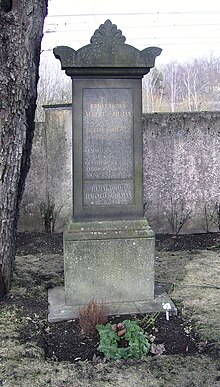August Sohlman
Per August Ferdinand Sohlman (born May 24, 1824 in Svennevad (now part of Hallsberg ) in the Närke countryside ; † July 5, 1874 in Algö in Baggensfjärden) was a Swedish journalist and politician.
His parents were the master carpenter Per Erik Sohlman and his wife, née Klingberg. He married Hulda Sandeberg in 1851.
Youth and Studies
He first went to school in Örebro , then to grammar school in Strängnäs . In 1843 he began his studies in Uppsala. There he became a member of the "Scandinavian Movement" and was also one of the main speakers for Scandinavianism at the student meetings in Uppsala in 1843 and in Copenhagen in 1845. Orla Lehmann's speech in Copenhagen, where he called for the blood brotherhood of the Nordic countries , made a particular impression on him . He became a member of the "Skandinaviska sällskapet" (Scandinavian Society) and was a co-founder of Studentbladet (student newspaper) in 1845 , which ceased its publication the following year.
In 1848 he passed his exams in philosophy. With his writing Om de äldsta ståndsförhållanden i Scandinavia. I. Trälen (About the oldest class relationships in Scandinavia. I. The slaves) he received his doctorate.
Professional background
Then he hurried first to Copenhagen as a volunteer in the sixth line battalion and with this to the theater of war in Schleswig to demonstrate the Scandinavian solidarity that had been sworn to. There he took part in many fights, about which he reported in Skandia magazine in 1850 . Returning from Malmö after the armistice, he wrote for the weekly Bore . At the same time he was a teacher of art history at the art academy. When Bore became the daily newspaper, he took over its management, but then merged it with the conservative newspaper Svenska tidningen . When Aftonbladet was bought by a consortium, he switched to this newspaper. In 1857 he became its editor-in-chief. He paid particular attention to the “Schleswig question” and “fennomania”. He also expressed the idea of founding a university in Stockholm for the first time in the Swedish press.
Journalistic work
He is considered to be one of the most important editors of his time, also respected by his opponents, because he always kept a polite tone even with the sharpest political feuds. Aftonbladet had a splendid time under his leadership and had a great influence on the development of the country. He took a Norway-friendly stance in the governor's dispute, but wanted to strengthen the Union at the same time. He only advocated equality for Norway after some hesitation, but then resolutely and fearlessly and thus opposed the majority of the Swedish population. This caused him a serious loss of readers. In general, he supported the diverse strivings for freedom of that time. He fought the next dispute in 1864 when, inspired by Scandinavianism, he advocated military support for Denmark against Prussia. He stood body and soul in the midst of the movement to join the war on Denmark's side and was a central figure in the "Nordiska Nationalföreningen". He was also a nationalist and was interested in Sweden's antiquities. He founded "Svenska fornminnesföreningen" (the Swedish antiquity association) and called for effective national defense. He was an avid shooter and one of the first leaders of the sniper movement and head of Stockholm's 9th Sniper Company. He also stood up for general conscription and general armament of the people. As a liberal, he was in favor of reforms in legislation for trading companies, for adult education centers, for extensive religious freedom and for improving opportunities for women to become self-employed. In doing so, he did not neglect his interests in art and culture. During his leadership of the art academy. From 1852 to 1853 he edited Nordisk tidskrift and published “Afhandlingar och skizzer uti kultur- och konsthistoriska ämnen”. One of the treatises was “Svenskt gymnasielif” (Swedish high school life), another “Det unga Finland” (Young Finland), where he dealt with “Fennomania”.
On July 5, 1874, he drowned in front of his summer house on Algö in the Baggensfjord when his sailing boat capsized and he tried to save the life of his underage son.
In the Scandinavian countries, a collection was then organized for the benefit of his widow and children.
Remarks
- ↑ Baggensfjärden is a large fjord within the Stockholm archipelago “Stockholms skärgård”.
- ↑ A line battalion was the name given to a unit whose soldiers were registered in a military role. This differentiated them from other units, for example the Landsturm or the Home Defense.
- ↑ Fennomania was the name given to a crush on Finnish. The movement emerged as a Finnish language movement in 1810. It developed from 1820-1850 and united many different patriotic goals. It was also about the dispute over the official language of the authorities and the bishop.
- ↑ The governor dispute was a dispute between Norway and Sweden, in which Norway demanded the abolition of the Swedish governor in Norway and equal treatment with Sweden within the Union.
literature
- Sohlman, Per August Ferdinand . In: Herman Hofberg, Frithiof Heurlin, Viktor Millqvist, Olof Rubenson (eds.): Svenskt biografiskt handlexikon . 2nd Edition. tape 2 : L – Z, including supplement . Albert Bonniers Verlag, Stockholm 1906, p. 481-482 (Swedish, runeberg.org ).
- T. Blanche: Sohlman, Per August Ferdinand . In: Theodor Westrin, Ruben Gustafsson Berg, Eugen Fahlstedt (eds.): Nordisk familjebok konversationslexikon och realencyklopedi . 2nd Edition. tape 26 : Slöke – Stockholm . Nordisk familjeboks förlag, Stockholm 1917, Sp. 272-275 (Swedish, runeberg.org ).
| personal data | |
|---|---|
| SURNAME | Sohlman, August |
| ALTERNATIVE NAMES | Sohlman, Per August |
| BRIEF DESCRIPTION | Swedish publicist |
| DATE OF BIRTH | May 24, 1824 |
| PLACE OF BIRTH | Svennevad , Sweden |
| DATE OF DEATH | July 5, 1874 |
| Place of death | Baggensfjärden |
